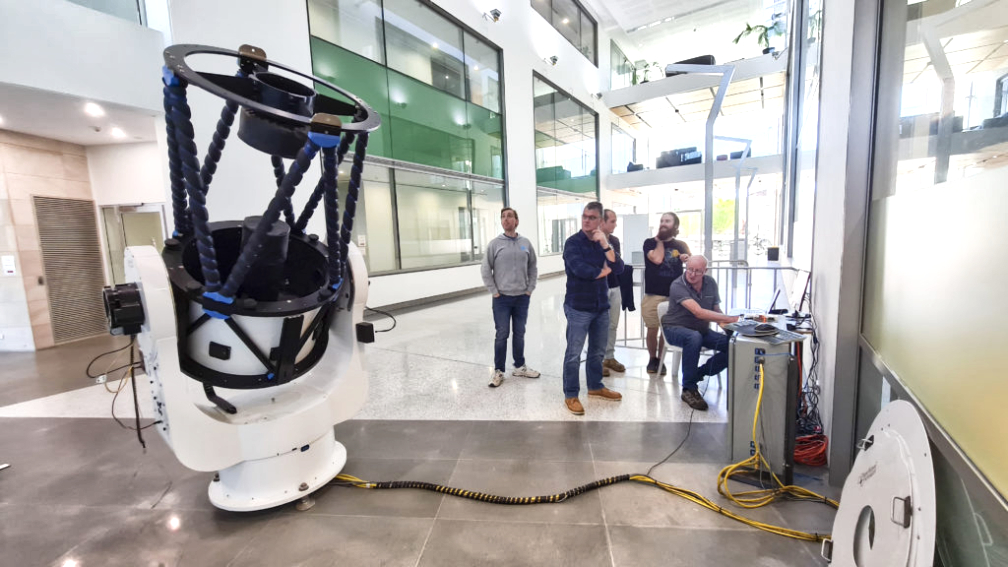
An optical communications station capable of receiving high-speed data transmissions from space is set to be built in Western Australia and will be installed by The University of Western Australia.
The advanced communications ground station will be able to receive data from spacecraft anywhere between LEO and the surface of the Moon. It has the potential to support ground-breaking space projects, including NASA’s Artemis mission to land the first woman and next man on the Moon by 2024.
This is a joint initiative of UWA’s Astrophotonics Group, which is part of the International Centre for Radio Astronomy Research (ICRAR), as well as the ARC Centre of Excellence for Engineered Quantum Systems (EQUS) and UK industry partner Goonhilly Earth Station.

The ground station was launched to coincide with the International Astronautical Congress. It will be part of a larger Australasian optical ground station network, led by the Australian National University, and with partners in South Australia, and New Zealand.
The station will use make use of a 0.7 meter observatory-grade optical telescope donated to ICRAR by Perth local Colin Eldridge. It will be fitted with advanced atmospheric-noise suppression technology developed at UWA.

The station will be connected to Goonhilly’s supercomputer data centre in Cornwall via high-speed fiber. Goonhilly handles data traffic and supports secure communications links for the world’s major satellite operators, including Intelsat, Eutelsat and SES Satellites. The company is also a partner in the European Space Agency’s Lunar Pathfinder Mission, which is scheduled to launch in 2022.
The $535,000 station is expected to be ‘on-sky’ in early 2021 and open for business later that year.
Executive Comments
Astrophotonics Group leader Dr. Sascha Schediwy from The University of Western Australia and ICRAR said optical communications was an emerging technology expected to revolutionize data transfer from space. He said, “Most current space communications rely on radio waves—it’s the same technology that brought us the voice of Neil Armstrong when the Apollo 11 mission landed on the Moon in 1969. Free-space optical laser communications has several advantages over radio, including significantly faster data rates and hack-proof data transfer. It’s the next-generation of space communications, and it’s likely to be how we’ll see high definition footage of the first woman to walk on the Moon.” He noted that WA’s ground station would help launch Australia’s space communications capacity, stating, “This will cement Australia’s position as a leader in optical data transmission, and position the nation to tap into the multi-billion-dollar space communications market.”
EQUS Director, Professor Andrew White, said the project, which could be the first ‘on-sky’ optical communications ground station in the Southern Hemisphere, was a prime example of fundamental research delivering real-world outcomes. He said, “EQUS delivers major impacts by encouraging and enabling our people to translate their research into tangible technologies and applications. We are building a culture of innovation, translation and commercialization among quantum science researchers in Australia. In addition to space communications, the ground station could also be used for applications ranging from cutting-edge fundamental physics to precision earth science and resource geophysics.”
Professor White added that the ground station would contribute to the development of the ‘quantum internet’—secure global data transmission using quantum-key distribution via optical links to quantum satellites and would stand as an example of cutting-edge science partnering with forward-looking businesses and delivering impacts for both.
Goonhilly Chief Executive Ian Jones said he was delighted to join forces with UWA, ICRAR and EQUS to establish an optical communications satellite ground station in Western Australia. He said, “We’ve been at the forefront of satellite communications since the start of the space age, and this is driving it into the next generation of systems and technologies to support the enormous data volumes emanating from space missions. This data arises from science and other missions and, in the future, will come from Lunar and Mars missions that involve remote operations, robotics and AI. We’re proud to be joint trailblazers in the practical implementation of coherent optical communications.”
UWA’s Astrophotonics Group Focused on designing, building, and testing advanced photonic systems with applications in radio astronomy, optical astronomy, and space science, the group’s core technological capability is the long-distance transfer of stabilized optical-frequency and microwave-frequency signals across optical fibre networks and free-space laser links.
ARC Centre of Excellence for Engineered Quantum Systems (EQUS) mission is to engineer the quantum future by building quantum machines that harness the quantum world for practical applications.
Goonhilly is a private UK-based company comprised of highly skilled professionals and experienced satellite communications engineers who have been involved in many of the innovations in satellite communications and space science in the past 30 years.
